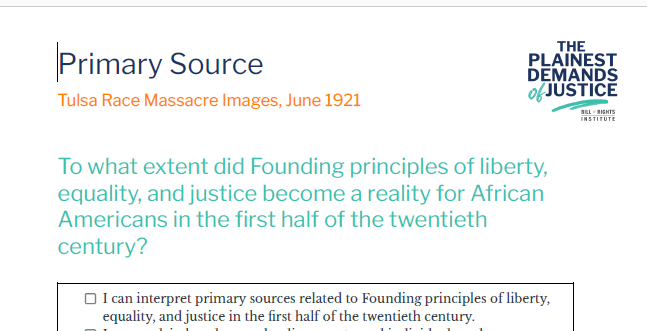Tulsa Race Massacre Images, June 1921
Guiding Question: To what extent did Founding principles of liberty, equality, and justice become a reality for African Americans in the first half of the twentieth century?
- I can interpret primary sources related to Founding principles of liberty, equality, and justice in the first half of the twentieth century.
- I can explain how laws and policy, courts, and individuals and groups contributed to or pushed back against the quest for liberty, equality, and justice for African Americans.
- I can create an argument using evidence from primary sources.
- I can analyze issues in history to help find solutions to present-day challenges.
Building Context
On May 31, 1921, police in Tulsa, Oklahoma, arrested a young Black man for allegedly assaulting a white woman in an elevator. A report in the local newspaper led to a confrontation between Black and white armed mobs at the jail where the young man, Dick Rowland, was being held. The spark of Rowland’s arrest led to an outburst of violence that resulted in the burning by whites of the Greenwood District, a wealthy Black American neighborhood of Tulsa known as “Black Wall Street.” Municipal and county authorities not only failed to calm or contain the violence but contributed to it, by providing weapons to white individuals and moving Black residents of Greenwood to holding centers. Upon entering the Greenwood District, armed whites stole, damaged, and destroyed property. The number of victims of the violence is still debated, but after it ended on June 1, the Greenwood District was effectively destroyed and its residents were homeless. The city did little to help them rebuild. The American Red Cross and private individuals helped Greenwood residents to recover after the disaster.
Tulsa Race Massacre Images, June 1921
Source Link: https://www.loc.gov/item/95517018/
Source Link: https://www.loc.gov/item/2017679760/
Smoke billowing over Tulsa, Oklahoma, during 1921 race massacre by Alvin C. Krupnick Co, 1921
Ruins after the race riots, Tulsa, Oklahoma, by Unknown Artist, 1921
Comprehension and Analysis Questions
- In 1921, Tulsa, like all southern cities at the time, was deeply segregated. How might this factor have contributed to the events of May 31 and June 1, 1921?
- Is it surprising that the municipal government did little to help the Greenwood residents rebuild? Why or why not?
- Today there is debate over whether this event should be called a riot or a massacre. Look up the definition of each term. Which do you think is more appropriate? Justify your response with specific evidence.


